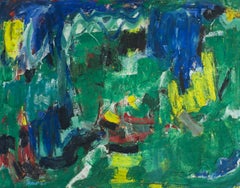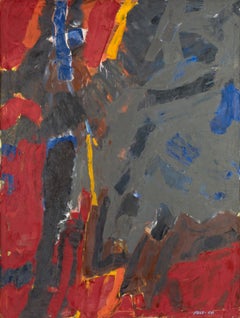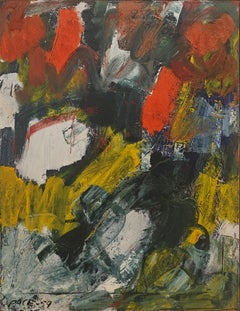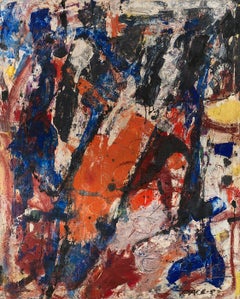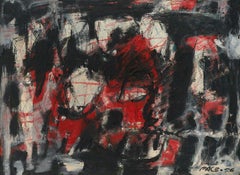Lincoln Glenn
to
141
525
244
144
131
87
82
61
60
50
47
44
44
39
30
24
22
21
20
20
14
14
12
10
7
6
4
28
18
15
14
14
"Untitled, 62-11" Stephen Pace, Blues and Greens, Cool Tones, Abstract Painting
By Stephen Pace
Located in New York, NY
Stephen Pace
Untitled, 62-11, 1962
Signed and dated lower left
Oil on canvas
50 x 64 inches
Born in Charleston, Missouri, Stephen Pace grew up in Indiana, where his parents operate...
Category
1960s Abstract Expressionist Abstract Paintings
Materials
Canvas, Oil
"Untitled, 58-A8" Stephen Pace, Dynamic Dark Red Abstract Expressionist Painting
By Stephen Pace
Located in New York, NY
Stephen Pace
Untitled, 58-A8, 1958
Signed lower right
Oil on canvas
64 x 48 inches
Born in Charleston, Missouri, Stephen Pace grew up in Indiana, where his parents operated a groce...
Category
1950s Abstract Expressionist Abstract Paintings
Materials
Canvas, Oil
"Untitled, 59-A12" Stephen Pace, Vibrant Yellow and Red, Intense Color Abstract
By Stephen Pace
Located in New York, NY
Stephen Pace
Untitled, 59-A12, 1959
Signed and dated lower left
Oil on canvas
29 x 24 inches
Born in Charleston, Missouri, Stephen Pace grew up in Indiana, where his parents operat...
Category
1950s Abstract Expressionist Abstract Paintings
Materials
Canvas, Oil
"Untitled, 58-26" Stephen Pace, Interlocking Forms, Blue and Black Abstract Work
By Stephen Pace
Located in New York, NY
Stephen Pace
Untitled, 58-26, 1958
Signed and dated lower left
Oil on canvas
56 x 40 inches
Born in Charleston, Missouri, Stephen Pace grew up in Indiana, where his parents operate...
Category
1950s Abstract Expressionist Abstract Paintings
Materials
Canvas, Oil
"Untitled, 57-10" Stephen Pace, Dynamic, Vibrant Orange, Abstract Expressionism
By Stephen Pace
Located in New York, NY
Stephen Pace
Untitled, 57-10, 1957
Signed and dated lower right
Oil on canvas
47 x 38 inches
Born in Charleston, Missouri, Stephen Pace grew up in Indiana, where his parents operat...
Category
1950s Abstract Expressionist Abstract Paintings
Materials
Canvas, Oil
"Untitled, 56-21" Stephen Pace, Pulsating Forms, Abstract Expressionist Painting
By Stephen Pace
Located in New York, NY
Stephen Pace
Untitled, 56-21, 1956
Signed and dated lower right
Oil on canvas
22 x 30 inches
Born in Charleston, Missouri, Stephen Pace grew up in Indiana, where his parents operat...
Category
1950s Abstract Expressionist Abstract Paintings
Materials
Canvas, Oil
"The Ordell, Brooklyn Bridge" Margaretha E. Albers, New York Urban Cityscape
By Margaretha E. Albers
Located in New York, NY
Margaretha E. Albers
The Ordell, Brooklyn Bridge
Signed LR
Oil on artist board
12 x 16 inches
Provenance
Kennedy Galleries, New York
Private Collection, New York
St. Lifer Art, New...
Category
1930s American Realist Figurative Paintings
Materials
Oil, Board
"Figure Study" Joseph Solman, Blue and Sepia, Pastel Colors Seated Study
By Joseph Solman
Located in New York, NY
Joseph Solman
Figure Study, circa 1959-60
Signed with initials lower left
Gouache on Racing Form newspaper
Sight 9 x 7 inches
Provenance
Private Collection, Montecito, California
Pr...
Category
1950s Modern Figurative Paintings
Materials
Paper, Gouache, Newsprint
"Alizarin Orionids" Charles Hinman, Work on Paper, Red Geometric Abstraction
By Charles Hinman
Located in New York, NY
Charles Hinman
Alizarin Orionids, 2003
Signed and dated lower right
Watercolor on paper
12 x 12 inches
Throughout his long career, Charles Hinman has collapsed the divide between p...
Category
Early 2000s Abstract Abstract Paintings
Materials
Paper, Watercolor
"Still Life with Cherries, Grapes" Annie L. Morgan, Academic Fruit Still Life
Located in New York, NY
Annie L. Morgan
Still Life with Cherries, Grapes, and Pomegranate, circa 1880
Signed lower left
Oil on canvas
20 x 16 inches
Category
1880s Academic Figurative Paintings
Materials
Canvas, Oil
"Untitled" Ray Parker, Color Field Lyrical Abstract, Blue and Magenta Painting
Located in New York, NY
Ray Parker
Untitled, 1969
Signed and dated on the reverse
Oil on canvas
32 x 32 inches
Provenance
Private Collection, New York
Ray Parker was born in 1922 in South Dakota. After c...
Category
1960s Color-Field Abstract Paintings
Materials
Canvas, Oil
"Untitled" Dan Christensen, Geometric Plaid Series, Orange and Blue Abstract
By Dan Christensen
Located in New York, NY
Dan Christensen
Untitled, circa 1970-71
Acrylic and enamel on canvas
44 x 20 inches
Provenance:
The artist
Sherron Francis (gift from the above)
Dan Christensen was an American abs...
Category
1970s Abstract Geometric Abstract Paintings
Materials
Enamel
"Nude" Marguerite Stuber Pearson, Female Nude, Outdoor Boston School, American
By Marguerite Stuber Pearson
Located in New York, NY
Marguerite Stuber Pearson
Nude, circa 1940
Signed lower right
Oil on artist board
20 x 16 inches
Marguerite Stuber Pearson was an American painter best known for her elegant portra...
Category
1940s Academic Figurative Paintings
Materials
Oil, Board
"His Master's Aim" Frank Califano, Trompe l'oeil, Photorealism, Italian Artist
Located in New York, NY
Frank Califano
His Master's Aim, circa 1922
Signed lower right
Oil on canvas
36 x 22 1/4 inches
Provenance
Zaplin-Lampert Gallery, Santa Fe, New Mexico
Private Collection (acquired ...
Category
1920s Photorealist Figurative Paintings
Materials
Canvas, Oil
"Autumn Landscape" Bruce Crane, Bright Orange, Luminous, Tonalist Fall Scene
By Bruce Crane
Located in New York, NY
Bruce Crane
Autumn Landscape
Signed lower right
Oil on canvas
16 x 24 inches
Bruce Crane Was born in New York City, he studied with Alexander H. Wyant before attending the Art Stud...
Category
1910s American Impressionist Figurative Paintings
Materials
Canvas, Oil
"Clearing after a Shower" Guy Wiggins, Impressionist Gloucester Schooners
By Guy Wiggins
Located in New York, NY
Guy Wiggins
Clearing after a Shower
Signed lower right, titled on verso
Oil on panel
12 x 16 inches
Guy Carleton Wiggins is best known for his impressionistic snow scenes of New Yo...
Category
1910s American Impressionist Figurative Paintings
Materials
Oil, Wood Panel
"Bass Rocks" Josephine Reichmann, Impressionist Surf, Luminous Waves, Seascape
Located in New York, NY
Josephine Reichmann
Bass Rocks
Signed lower right
Oil on canvasboard
14 x 16 inches
Reichmann was born in 1864 in Louisville, Kentucky. After studying at the School of the Art Inst...
Category
1920s American Impressionist Landscape Paintings
Materials
Canvas, Oil, Board
"Near Bourron, France" Gilbert Munger, Barbizon School, Countryside Landscape
Located in New York, NY
Gilbert Munger
Near Bourron, France, circa 1886
Signed lower left
Oil on panel
13 x 18 inches
Gilbert Munger was born on April 14, 1837 in Madison, Connecticut. He showed interest ...
Category
1880s Barbizon School Figurative Paintings
Materials
Oil, Wood Panel
"Old Whaling Wharf, Newport, Rhode Island" Paulette Van Roekens, Impressionist
Located in New York, NY
Paulette Van Roekens
Old Whaling Wharf, Newport, Rhode Island, 1921
Signed and dated lower left
Oil on canvas
30 x 40 inches
Painter Paulette van Roekens was born in France and attended the Philadelphia School of Design for Women (now Moore College of Art and Design) and the Pennsylvania Academy of the Fine Arts. Her talent was recognized early on, and in 1916, she was awarded the John Sartain Fellowship at the Philadelphia School of Design. Her early paintings often were of still lifes, using flowers...
Category
1920s American Impressionist Figurative Paintings
Materials
Canvas, Oil
"Winter Landscape" Wilson Irvine, Atmospheric Impressionist Snowy Hills
Located in New York, NY
Wilson Irvine
Winter Landscape
Signed lower left
Oil on canvas
24 x 27 inches
A prolific Impressionist with a penchant for atmospheric scenes, Illinois native Wilson Irvine began h...
Category
1910s American Impressionist Figurative Paintings
Materials
Canvas, Oil
"Park Street, Boston" Arthur Clifton Goodwin, Impressionist Snowy Urban Scene
By Arthur Clifton Goodwin
Located in New York, NY
Arthur Clifton Goodwin
Park Street, Boston
Signed lower right
Oil on canvas
25 x 30 inches
A painter especially known for street and waterfront scenes of Boston, Arthur Clifton Goo...
Category
1920s American Impressionist Figurative Paintings
Materials
Canvas, Oil
"Boston Square" Arthur Clifton Goodwin, Impressionist Boston Urban Landscape
By Arthur Clifton Goodwin
Located in New York, NY
Arthur Clifton Goodwin
Boston Square
Signed lower left
Oil on canvas
30 x 36 inches
A painter especially known for street and waterfront scenes of Boston, Arthur Clifton Goodwin di...
Category
1920s American Impressionist Figurative Paintings
Materials
Canvas, Oil
"White Horse" Frederick Lester Sexton, Bucolic Barn, Farm Scene, White Horse
By Frederick Lester Sexton
Located in New York, NY
Frederick Lester Sexton
White Horse
Signed lower right
Oil on canvas
25 x 30 inches
Provenance
Part of a Collection received from the Lyme Art Association.
Frederick Lester Sexton received a lot of reviews and exhibitions in the 1920s, 1930s, and 1940s, when he was at the height of his career. Because it captured the personal view of many people's wish to ignore national issues and simply live their lives in their homes, his work was favorably welcomed. The rise of modernist styles like Abstract Expressionism, which started to take over the American art scene in the 1950s, also contributed to Sexton's fall in popularity. As collectors and regular spectators discover once more that realism is a valid component of American art because it speaks directly and clearly to the beauty they perceive in their surroundings, many artists, like Sexton, are experiencing a renaissance.
Cheshire, Connecticut, was the birthplace of Frederick Sexton in 1889. His father, J. Frederick Sexton, was the Rector of St. Peter's Church in Cheshire and a well-known Episcopal clergyman. The mother, Mary Louise Lester, was an amateur painter and came from a pretty well-known Hartford family. Frederick was killed in an open-hearth fire when he was eighteen months old. His right hand was badly burned and was never to be opened again. The father kept the family together after his mother passed away when he was nineteen.
Sexton's mother taught him art, and he went to public schools in New Haven. He received the prestigious Winchester Prize for a year of study in Spain while attending the Yale School of Fine Art, where he studied under Augustus Tack...
Category
1930s American Impressionist Figurative Paintings
Materials
Canvas, Oil
"Autumn, New England" Charles Warren Eaton, Tonalist Gloaming Sunset in Woods
By Charles Warren Eaton
Located in New York, NY
Charles Warren Eaton
Autumn, New England
Signed lower right
Oil on canvas
30 x 36 inches
Provenance
Private Collection, Connecticut
A contemporary critic wrote that the paintings o...
Category
Early 1900s Tonalist Figurative Paintings
Materials
Canvas, Oil
"Trail of the Snowshoes" William Baxter Closson, Lyrical Snowy Landscape
By William Baxter Closson
Located in New York, NY
William Baxter Closson
Trail of the Snowshoes, circa 1910
Signed lower right
Oil on canvas
30 x 40 inches
Provenance
The Cooley Gallery, Old Lyme, Connecticut
Born October 13, 184...
Category
1910s American Impressionist Figurative Paintings
Materials
Canvas, Oil
"Hillside Landscape" Edwin Child, Farmland, Vast Rural Mountainous Landscape
Located in New York, NY
Edwin Child
Hillside Landscape, 1896
Signed and dated lower right
Oil on canvas
18 x 28 inches
Edwin Burrage Child was a prominent New England portraitis...
Category
1890s American Impressionist Figurative Paintings
Materials
Canvas, Oil
"Building the Westside Highway" Frida Gugler, 1930s New York City Urban Scene
Located in New York, NY
Frida Gugler
Building the Westside Highway (Near the George Washington Bridge), circa 1935-37
Signed lower right
Oil on canvas
20 x 28 inches
Born in Milwaukee, Wisconsin, the pain...
Category
1930s American Realist Figurative Paintings
Materials
Canvas, Oil
"Crashing Waves at Sunset" William Formby Halsall, Dramatic Pink Sunset Seascape
Located in New York, NY
William Formby Halsall
Crashing Waves at Sunset
Signed lower right
Oil on canvas
18 x 30 inches
Marine painter William Formby Halsall was born in Kirkdale, England, in 1841. He was...
Category
1880s Impressionist Figurative Paintings
Materials
Canvas, Oil
"Winter Silence" Carl Wuermer, American Impressionism Quiet Snowy Landscape
By Carl Wuermer
Located in New York, NY
Carl Wuermer
Winter Silence
Signed lower left
Oil on canvas
25 x 30 inches
Known for serene, realistic landscapes, he was a widely exhibited painter who won numerous awards includi...
Category
1920s American Impressionist Figurative Paintings
Materials
Canvas, Oil
"Winter Landscape" Dale Bessire, Impressionist American Snowy Landscape
Located in New York, NY
Dale Bessire
Winter Landscape
Signed lower right
Oil on canvas
20 x 24 inches
A founding member of the Brown County Art Gallery Association, Dale Bessire was a native of Indianapol...
Category
1910s American Impressionist Figurative Paintings
Materials
Canvas, Oil
"Rockport" William Lester Stevens, North East Coastal American Landscape
By William Lester Stevens
Located in New York, NY
William Lester Stevens
Rockport
Signed lower right
Oil on canvas
20 x 24 inches
Born on June 15, 1888, in Rockport, Massachusetts, Stevens displayed his artistic abilities from a y...
Category
1920s American Impressionist Figurative Paintings
Materials
Canvas, Oil
"Hialeah Park Race Track, Florida" Beatrix Sherman, American, Mid 20th Century
Located in New York, NY
Beatrix Sherman
Hialeah Park Race Track, Florida, 1947
Signed lower right
Oil on canvasboard
16 x 20 inches
Beatrix Sherman (1894-1975), who changed her first name from Beatrice by...
Category
1940s American Realist Figurative Paintings
Materials
Canvas, Oil, Board
"Pigeon Hill, Rockport" Winthrop Duthie Turney, North Eastern American Landscape
Located in New York, NY
Winthrop Duthie Turney
Pigeon Hill, Rockport
Signed lower left
Oil on canvas
20 x 24 inches
Exhibited
New York, National Academy of Design, Artists of America, Sixth Annual Exhibition, 1949.
Winthrop Duthie Turney was born in New York City and received his education at the Art Students League. He was affiliated with the Fifteen Gallery...
Category
1920s American Impressionist Figurative Paintings
Materials
Canvas, Oil
"Winter Landscape" William Lester Stevens, Cape Ann Snowy Landscape
By William Lester Stevens
Located in New York, NY
William Lester Stevens
Winter Landscape
Signed lower right
Oil on canvas
32 x 36 inches
Born on June 15, 1888, in Rockport, Massachusetts, Stevens displayed his artistic abilities ...
Category
1920s Modern Figurative Paintings
Materials
Canvas, Oil
"Farmhouses in Autumn, Giverny" Theodore Earl Butler, American Impressionism
By Theodore Earl Butler
Located in New York, NY
Theodore Earl Butler
Farmhouses in Autumn, Giverny
Signed "T.E. Butler" lower right
Oil on canvas
21 1/4 x 25 1/2 inches
Provenance
The artist.
Estate of the above.
By descent throu...
Category
1890s American Impressionist Figurative Paintings
Materials
Canvas, Oil
"Village Green" Mary Bradish Titcomb, Bright American Impressionist Landscape
Located in New York, NY
Mary Bradish Titcomb
Village Green
Signed lower left
Oil on canvas
24 x 20 inches
A native of Windham, New Hampshire, upon graduation from high school, Titcomb studied at the Massachusetts Normal Art School, before accepting a position as a drawing teacher in the public schools of Brockton, Massachusetts, where she remained for fourteen years before resigning, in 1889, to study painting at the School of the Museum of Fine Arts, Boston. Her instructors there included Edmund Charles Tarbell, Philip Leslie Hale, and Frank Weston Benson. In the 1890s she went to Paris to study with Jules Joseph Lefebvre and to travel. She then returned to Boston, taking studio space at the Harcourt Studios, where all three of her teachers kept space. In 1895 she became a member of the Copley Society and began exhibiting locally; from 1904 to 1927 she showed work in 29 exhibits at the Pennsylvania Academy of the Fine Arts. She began signing her name as "M. Bradish Titcomb" in 1905 to avoid prejudice against her gender. The same year saw her making a sketching trip to the artists' colony at Old Lyme, Connecticut, a center for the American Impressionists; this trip seems to have cemented her interest in the style.
In 1915, Titcomb's Portrait of Geraldine J. – the mother of actress Jane Russell – was shown at the Corcoran Gallery of Art and purchased by President Woodrow Wilson; another portrait, of Frank P. Sibley, was reproduced in the Boston Globe. During this period her work was shown in a traveling exhibition with that of Cecilia Beaux, Lydia Field Emmet, Jean MacLane...
Category
1910s American Impressionist Figurative Paintings
Materials
Canvas, Oil
"Make 300 Holes with Any Implement: This Is My Gift" Takako Saito, Concept Art
Located in New York, NY
Takako Saito
Make 300 Holes with Any Implement: This Is My Gift , 1965
Wood box containing wood frame with paper and stamped ink
3 3/8 × 3 3/8 × 1 1/4
Takako Saito is a Japanese ar...
Category
1960s Conceptual Abstract Sculptures
Materials
Wood, Paper, Ink
"Secret Santa" Takako Saito, Fluxus Movement Conceptual Construction, Sculpture
Located in New York, NY
Takako Saito
Secret Santa , 1965
Stamped inscribed in pen recipients name
Wood construction
1 1/2 x 1 1/4 x 1 1/4 inches
Takako Saito is a Japanese artist closely associated with F...
Category
1960s Conceptual Abstract Sculptures
Materials
Wood
"Mystery Box (Boîte mystère)" Ben Vautier, Fluxus Movement Conceptual Sculpture
By Ben Vautier
Located in New York, NY
Ben Vautier
Mystery Box (Boîte mystère), 1965
Painted wood with letterpress label
3 13/16 × 2 3/4 × 2 7/16 inches
Ben Vautier was a French artist known for his text-based paintings...
Category
1960s Conceptual Abstract Sculptures
Materials
Wood, Paper
"Tempole" Seymour Franks, Bright Red and Yellow, Abstract Mid-Century Painting
By Seymour Franks
Located in New York, NY
Seymour Franks
Tempole, 1948
Signed lower right; signed, dated, titled on verso
Oil on canvas
35 x 42 inches
American painter and designer, Seymour Franks, was born in New York Ci...
Category
1940s Abstract Abstract Paintings
Materials
Canvas, Oil
"Paulson" Seymour Franks, Modernist, Blue, White and Green Abstraction
By Seymour Franks
Located in New York, NY
Seymour Franks
Paulson, 1949
Signed lower left
Signed, titled, dated on verso
Oil on canvas
46 x 30 inches
American painter and designer, Seymour Franks, was born in New York City ...
Category
1940s Abstract Abstract Paintings
Materials
Canvas, Oil
"Thelo #1" Diana Kurz, Abstract Expressionist Gestural Purples and Blues
By Diana Kurz
Located in New York, NY
Diana Kurz
Thelo #1 , 1961
Oil on canvas
64 x 55 1/2 inches
Diana Kurz (born 1936) is an Austrian-born feminist painter. In 1938, Diana Kurz's family fled Austria, first to England...
Category
1960s Abstract Expressionist Abstract Paintings
Materials
Canvas, Oil
"Woodland and Stream" Theresa Bernstein, Red Green Yellow Abstracted Landscape
By Theresa Bernstein
Located in New York, NY
Theresa Bernstein
Woodland and Stream, circa 1980
Signed Lower Right
Oil on canvas
19 x 23 inches
Theresa F. Bernstein was born in Philadelphia in 1895 to cultured, middle-class im...
Category
1980s Expressionist Figurative Paintings
Materials
Oil, Canvas
"The Gathering" Theresa Bernstein, Abstracted Figures Ashcan School Artist
By Theresa Bernstein
Located in New York, NY
Theresa Bernstein
The Gathering, circa 1990
Signed lower right
Mixed media on paper
9 x 10 3/4 inches
Theresa F. Bernstein was born in Philadelphia in 1895 to cultured, middle-clas...
Category
1990s Abstract Abstract Drawings and Watercolors
Materials
Paper, Mixed Media
"Phlox" Nina Hill, Pastel Colors, Pink Impressionist Flowers Still Life
Located in New York, NY
Nina Hill
Phlox, circa 1925
Signed lower left
Oil on canvas
24 x 20 inches
Newcomb Macklin Frame
Category
1920s Impressionist Figurative Paintings
Materials
Canvas, Oil
"Untitled" Theresa Bernstein, Expressionist Work by American Ashcan Artist
By Theresa Bernstein
Located in New York, NY
Theresa Bernstein
Untitled, circa 1990
Signed lower right
Oil on canvas
16 x 20 inches
Theresa F. Bernstein was born in Philadelphia in 1895 to cultured, middle-class immigrant par...
Category
1990s Abstract Abstract Paintings
Materials
Canvas, Oil
"Untitled" Steven Pace, Second Generation Abstract Expressionist Painting
By Stephen Pace
Located in New York, NY
Stephen Pace
Untitled, 58-06, 1958
Oil on canvas
54 x 41 inches
Born in Charleston, Missouri, Stephen Pace grew up in Indiana, where his parents operated a grocery store and then a...
Category
1950s Abstract Expressionist Abstract Paintings
Materials
Canvas, Oil
"Anyone for Croquet" Herbert Gustave Schmalz, Portrait by Pre-Raphaelite Artist
Located in New York, NY
Herbert Gustave Schmalz
Anyone for Croquet, circa 1898
Signed lower right
Oil on canvas
47 5/8 x 31 3/4 inches
Provenance
Anthony Mitchell, Nottingham
Burlington Gallery Ltd., Londo...
Category
1890s English School Figurative Paintings
Materials
Canvas, Oil
"Pompeian Perfumer" Grace Hartigan, Roman Subject, Abstract Expressionist Artist
By Grace Hartigan
Located in New York, NY
Grace Hartigan
Pompeian Perfumer, 1999
Signed and dated lower right; signed, titled, and dated on the reverse
Oil on linen
72 x 66 inches
Grace Hartigan’s career began among the Ne...
Category
1990s Abstract Expressionist Figurative Paintings
Materials
Canvas, Linen, Oil
"Why Didn't You Tell Me About Your Bicycle" Ray Johnson, Drawing, Mail Art
By Ray Johnson
Located in New York, NY
Ray Johnson
Why Didn't You Tell Me About Your Bicycle, Janurary 1968
Red ink on postcard
3 1/2 x 5 1/2 inches
Once described as New York’s “most famous unknown artist,” Ray Johnson...
Category
1960s Conceptual Mixed Media
Materials
Mixed Media
"Venice" Ray Johnson, Mail Art, Fluxus Mixed Media Collage, Dadaist Work
By Ray Johnson
Located in New York, NY
Ray Johnson
Venice
Signed lower right
Collage
6 x 4 1/2 inches
Once described as New York’s “most famous unknown artist,” Ray Johnson was a renowned maker of meticulous collages an...
Category
1960s Conceptual Mixed Media
Materials
Mixed Media
"Moon" Ray Johnson, Minimalist Mixed Media on Masonite, Fluxus Movement
By Ray Johnson
Located in New York, NY
Ray Johnson
Moon
Mixed media on Masonite
8 3/4 x 6 1/2 inches
Once described as New York’s “most famous unknown artist,” Ray Johnson was a renowned maker of meticulous collages and...
Category
1960s Conceptual Mixed Media
Materials
Masonite, Mixed Media
"Valentine" Ray Johnson, 2 Sided Collage, Pop Art, Dadaist, Mail Art, Fluxus
By Ray Johnson
Located in New York, NY
Ray Johnson
"Valentine"
Double sided collage
6 1/2 x 4 1/4 inches
Once described as New York’s “most famous unknown artist,” Ray Johnson was a renowned maker of meticulous collages...
Category
1960s Conceptual Mixed Media
Materials
Paper, Photographic Paper
"Kuhn Family Holiday Card" Walt Kuhn, Greeting Card by American Modernist
By Walt Kuhn
Located in New York, NY
Walt Kuhn
Kuhn Family Holiday Card
Lithograph on paper
6 1/4 x 3 3/4 inches
Walter Kuhn was born on October 27, 1877 in Brooklyn, NY. His father, Francis Kuhn, was the owner of a s...
Category
1930s Modern Figurative Prints
Materials
Lithograph
"Kuhn Family Holiday Card" Walt Kuhn, Greeting Card by American Modernist
By Walt Kuhn
Located in New York, NY
Walt Kuhn
Kuhn Family Holiday Card
Lithograph on paper
5 1/2 x 4 inches
Walter Kuhn was born on October 27, 1877 in Brooklyn, NY. His father, Francis Kuhn, was the owner of a ship ...
Category
1930s Modern Figurative Prints
Materials
Lithograph
"John Van Schaick Lansing Pruyn" Eastman Johnson, Prominent Gentleman Portrait
By Eastman Johnson
Located in New York, NY
Eastman Johnson
John Van Schaick Lansing Pruyn, 1883
Initialed and dated lower left
Oil on canvas
28 x 18 inches
For many years the foremost genre painter in the United States, Eas...
Category
1880s Academic Figurative Paintings
Materials
Canvas, Oil
"Still Life of Fish" William Merritt Chase, American Impressionist Bravura
By William Merritt Chase
Located in New York, NY
William Merritt Chase
Still Life of Fish
Signed lower right
Oil on canvas
32 x 39 1/2 inches
Provenance
Francis E. Myers, III, Ashland, Ohio
Butler Institute of American Art, Youngs...
Category
Early 1900s American Impressionist Still-life Paintings
Materials
Canvas, Oil
"Final Edition" Virginia Berresford, Precisionist Cemetery, Social Realism
By Virginia Berresford
Located in New York, NY
Virginia Berresford
Final Edition, 1937
Signed and dated lower right
Oil on canvas
17 x 25 inches
Provenance
Montross Gallery, New York
D. Wigmore Fine Art, New York
Private Collect...
Category
1930s American Modern Figurative Paintings
Materials
Canvas, Oil
"Untitled" Gene Hedge, Abstract Color Field, Purple Orange Blue Midcentury Work
Located in New York, NY
Gene Hedge
Untitled, circa 1970
Acrylic on canvas
48 x 18 inches
Provenance
Estate of the artist
Gene Hedge was born (1928) and raised in rural Indiana. After military service, he...
Category
1970s Abstract Abstract Paintings
Materials
Acrylic
"Untitled" Gene Hedge, Abstract Color Field, Red Blue Orange Midcentury Painting
Located in New York, NY
Gene Hedge
Untitled, circa 1970
Acrylic on canvas
48 x 18 inches
Provenance
Estate of the artist
Gene Hedge was born (1928) and raised in rural Indiana. After military service, he...
Category
1970s Color-Field Abstract Paintings
Materials
Canvas, Acrylic
